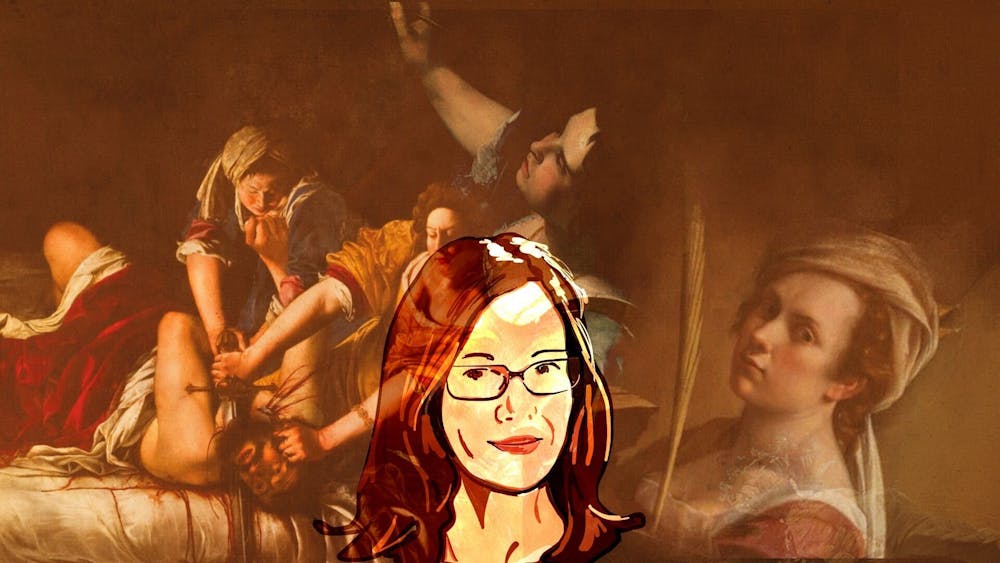“Artemisia Gentileschi, was in almost every aspect of her life, a path breaker … [she] established herself as an equal of any male artist of her time” says History of Art professor Sheila Barker. “Because of her unorthodox and brazen path in life, [she] was always surrounded by controversy.”
Hundreds of years after her death c.1656, Gentileschi remains the subject of debate. Recently, the curators of an exhibition at the Gallerie d’Italia in Naples titled “Artemisia Gentileschi in Naples” have given full attributions to the artist for four works. Because Gentileschi collaborated extensively with other painters in her studio, the question of attribution is complicated and subject to much academic discourse.
Of the 21 images involved in the exhibition, which remains open until March 19, Triumph of Galatea (c. 1650) is one that has been re-evaluated in terms of authorship. The painting is on loan from the National Gallery of Art, which attributes the work solely to Cavallino, claiming that “examination of the work has found no evidence of the separate hands of both Artemisia, to whom the commission was awarded, and Cavallino.” Curators of the Naples exhibition, on the other hand, believe that because the works were created in Gentileschi’s workshop she “is the owner of the commission and the creator of the composition,” as Giuseppe Porzio says.
Difficulties and complexities surrounding the attribution process have also affected three other works of art originating in Gentileschi’s studio, including Israelites Celebrating the Return of David, Bathsheba at her Bath, and Susanna and her Elders. Some attribute the works broadly to her workshop, and some to other male artists with whom she worked, like Bernardo Cavallino, Domenico Gargiulo, or Onogrio Palumbo.
While attribution may seem like a minor nuance, in the case of Gentileschi especially, it is more than pertinent. Such a discovery, if convincing to the majority of Gentileschi scholars and curators, will give additional perspective into the artist’s fame. It will also allow the works to be better preserved for future generations, according to Barker, who also serves as the Executive Director of Studio Incamminati School for Contemporary Realist Painting and is the titular Founding Director of the Research Program on Women Artists at the Medici Archive Project. With a larger library of Gentileschi’s works, academics have the opportunity to uncover more about her technical skill, patronage, workshop, and overall contributions to artistic canon. Barker elaborates, “We learned more about the success of her business enterprise because the more we see multiple hands contributing to these paintings, the more we know that she had a bustling workshop full of lots of people working underneath her,” she says. “And of course, that multiplicity of hands is exactly why it's so hard for our art critics and art experts to agree about an attribution.”
In terms of Gentileschi’s work, her unique story, including her mother’s death and her brutal rape as a teenager, are both reflected within and countered by each studied brush stroke. According to Barker, within Gentileschi’s work she discusses “not only the realities that men and women of her time deal with, but depicts a world in which the potentiality of individuals has no limits, and the great, the brave, the good, the courageous I always win.”
Interestingly, although she was a woman living in a religiously conservative and masculinist society, Gentileschi was widely recognized and celebrated. Her esteemed patrons included the King of Spain, Pope Urban the Eighth, and King Charles of England. Barker believes correct attributions allow us to see the wit and inventiveness behind her undeniable success—they expose the real issues that impact a woman’s ability to achieve and ultimately act as valuable shortcuts for helping women thrive even today. She asks, “how can we give young women with talent and drive the necessary things they need to excel and to reach their capacity and their potentiality for greatness?”
The developing story of Gentileschi should motivate the art historical discipline to do more for women artists. Barker notes that even at the University of Pennsylvania, only one History of Art course dedicated entirely to a woman has been taught. While previous courses have focused on male artists like Michelangelo or Andy Warhol, only one such course was taught by Barker roughly two years ago. She hopes that the continued revision and relevance of Gentileschi will serve as a challenge to her colleagues, both at the University and beyond, stating that “the history of art is incomplete without [the] stories of women like Artemisia."







